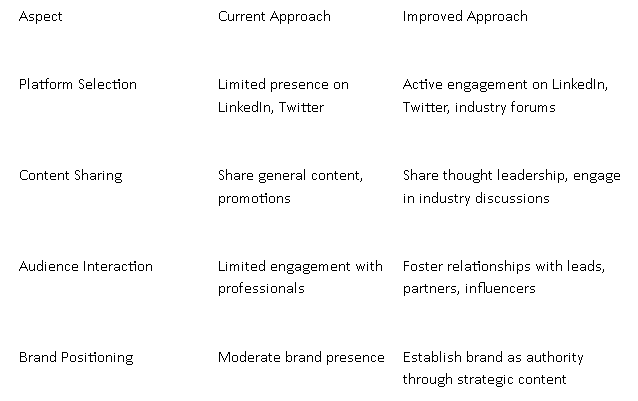As a biotech marketer, reaching the right audiences with messaging that resonates is crucial for success, yet often challenging. You need to connect with diverse groups such as researchers, healthcare providers, investors, and more – each with their own priorities and decision-making criteria.
Effectively communicating complex scientific concepts is also essential. Crafting marketing campaigns that effectively engage these distinct groups is no easy task. However, by following key principles tailored to the biotech industry, you can craft strategies that resonate, build brand awareness, and ultimately drive sales growth.
This article will outline how you can craft marketing strategies tailored to the unique needs of the biotech industry. We’ll cover techniques for optimizing performance, setting goals, understanding your audiences, gaining a competitive edge, leveraging digital and social channels effectively, building thought leadership, mastering email marketing, and continuously refining your approach for maximum impact.
Optimizing Your Marketing Performance
The first step in refining your marketing is to thoroughly evaluate your current efforts and pinpoint areas for improvement. While there are many potential metrics to track, some of the important KPIs to focus on include lead generation rates, audience engagement levels, and the health of your sales pipeline.
Only about 10% of biotech brand strategic plans include clear, measurable objectives aligned with these crucial KPIs – a significant missed opportunity. You should be leveraging specialized data analytics tools to gain deep visibility into your performance, competitor strategies, and target audience behavior.
Leveraging Digital Marketing
Content marketing should be a cornerstone of your digital biotech marketing efforts. Some of the effective content types include:
- Extensive, data-driven whitepapers and books covering key scientific topics
- Webinars and video interviews featuring internal subject matter experts
- Authoritative blog posts that break down complex diseases and treatments
- Interactive tools and calculators that showcase your product applications
To maximize content visibility, invest in keyword research and optimize your assets for search using relevant biotech/scientific terminology. Leverage schema markup to increase visibility in search features and results. Often, teams struggle to engage the right audience or effectively communicate complex scientific concepts. These difficulties can lead to reduced impact and missed opportunities in targeted sectors. Biotech marketing solutions can adeptly bridge these gaps. By integrating advanced analytics and tailored content strategies, biotech marketing solutions enhance outreach and comprehension among scientific communities, thereby improving engagement and driving successful outcomes.
Goal-Setting for Biotech Marketing
With a solid understanding of your current metrics, you can then set well-defined SMART (Specific, Measurable, Achievable, Relevant, Time-bound) goals to guide your marketing initiatives. Effective goals for biotech companies to consider include:
- Increasing high-quality marketing qualified leads by 25% over the next 6 months
- Boosting website traffic from healthcare professionals by 40% this year
- Achieving 50% annual recurring revenue growth from new product launches
The importance of having clear goals cannot be overstated – nearly 40% of global drug sales are now generated by biopharmaceuticals. Well-defined objectives are essential for capitalizing on this lucrative market opportunity.
Developing Target Audience Insights
To craft messaging that resonates, you must invest time in deeply understanding the diverse audiences you’re targeting. While there is some overlap, each of the key segments such as academic researchers, healthcare providers, patients, environmental organizations, and investors has distinct priorities.
For instance, pharmaceutical companies and researchers may place the highest value on scientific rigor, cutting-edge innovation, and data transparency. Healthcare practitioners are more focused on patient outcomes and practical applications. And investors prioritize financial projections, market sizing, and growth potential.
By developing rich audience personas through tactics such as focus groups, surveys, and interviews, you can map your messaging to address their specific pain points and interests.
Major audience segments you should aim to understand include:
- Academic and research institutions
- Healthcare providers (physicians, hospitals, insurers)
- Patients and patient advocacy groups
- Agricultural and environmental organizations
- Investors and industry analysts
Gaining a Competitive Edge
Conducting a thorough competitive analysis is critical for identifying unique opportunities to differentiate your biotech brand in the market. This should involve:
- Clearly identifying your key competitors in each product and therapeutic area
- Evaluating their marketing strategies across content, channels, and messaging
- Analyzing their strengths, weaknesses, and whitespace opportunities
- Defining your unique value propositions you can promote
With clear competitive insights, you can refine your strategies to cost-effectively capture more market share.
Social Media Strategies
While the specific approach varies by sub-sector, LinkedIn and Twitter are generally the high-impact social platforms for biotech marketing initiatives. On LinkedIn, you can:
- Share thought leadership content and news via company page posts
- Promote webinars, product launches, and career opportunities
- Participate in discussions within professional life sciences Groups
- Identify potential leads, customers, partners, and employees
For biotech brands on Twitter, the focus should be on joining relevant conversations, sharing engaging multimedia content, and connecting with industry influencers. An active, strategic approach can help position your brand as an authority.

Establishing Thought Leadership
To build credibility and brand trust, a core part of your marketing efforts should be centered around solidifying your organization as a respected thought leader. Formats for effective thought leadership content include:
- Webinars and video content featuring your internal scientific experts
- Detailed whitepapers exploring the latest research in key focus areas
- Bylined articles and commentary in respected trade publications
- Speaking engagements and presentations at major industry conferences
Seek opportunities to produce educational assets that make highly technical content understandable for audiences without deep scientific backgrounds. A mix of written, video, and multimedia content can increase engagement.
An example would be hosting a quarterly webinar series that breaks down emerging fields such as gene therapy, proteomics, or synthetic biology and their potential biotech applications.
Mastering Email Marketing
Despite the rise of new channels, email remains one of the powerful tools in a biotech marketer’s arsenal – particularly for nurturing leads through the sales cycle. However, effectiveness requires adhering to modern practices:
- Segmenting your email lists based on key audience demographics and interests
- Delivering personalized messaging and content tailored to where they are in their buyer’s journey
- Closely tracking engagement metrics such as open rates, clicks, and conversions
- Setting up automated nurture campaigns with strategic calls-to-action and follow-ups
- Using gated premium content such as reports and tools to capture leads
For example, you could create an 8-email automated nurture sequence promoting an upcoming virtual bioprocessing workshop, and deliver it to contacts who downloaded related ebooks or attended past webinars on the topic.
Continuous Refinement and Optimization
The final piece of the biotech marketing puzzle is approaching your strategies with an optimization mindset. Marketing is an iterative process, so you need systems in place to continually test, measure, and enhance your campaigns over time. This includes:
- Regularly A/B testing email campaigns, ads, websites, and other core components
- Carefully analyzing performance data in your marketing analytics platforms
- Gathering voice-of-customer feedback through surveys and focus groups
- Updating messaging, creative, channels based on changing needs
- Reallocating budgets towards your effective and highest-impact initiatives
Adopting a data-driven approach to refine your marketing mix continually ensures your brand stays fresh and relevant and delivers strongly.
Following the tips and optimal practices outlined above can position you to execute strategic and effective marketing campaigns tailored to your unique biotech audiences. The payoff? Potentially increased brand awareness and credibility, higher-quality lead generation, and sustainable growth.
Ready to maximize your biotech marketing strategy and results? Sign up for our free weekly newsletter featuring cutting-edge industry insights.
Published By: Aize Perez

















